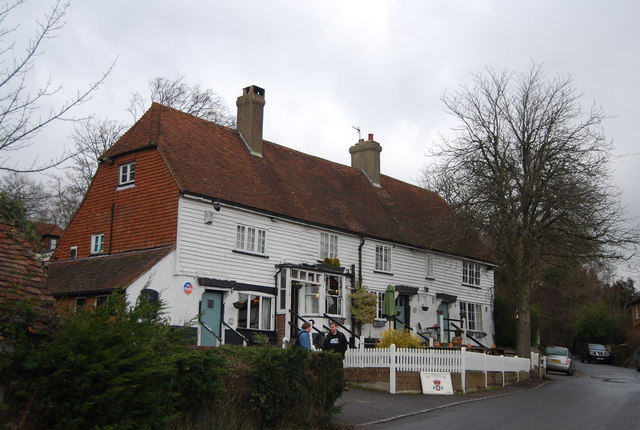TQ5927 : Rose and Crown Inn
taken 12 years ago, near to Mayfield, East Sussex, England

Weatherboarding is the cladding of a house consisting of long thin timber boards that overlap one another on the outside of the wall.
Traditionally timber weatherboarding was used without a finish, relying upon good air circulation and the use of 'semi-hardwoods' which would keep the boards from rotting. More recently weatherboarding has been tarred or painted; traditionally black or white due to locally occurring minerals or pigments.
Weatherboard houses may be found in most parts of the British Isles, and the style may be part of all types of traditional buildings, from cottages to windmills, shops to workshops.
Listed buildings and structures are officially designated as being of special architectural, historical or cultural significance. There are over half a million listed structures in the United Kingdom, covered by around 375,000 listings.
Listed status is more commonly associated with buildings or groups of buildings, however it can cover many other structures, including bridges, headstones, steps, ponds, monuments, walls, phone boxes, wrecks, parks, and heritage sites, and in more recent times a road crossing (Abbey Road) and graffiti art (Banksy 'Spy-booth') have been included.
In England and Wales there are three main listing designations;
Grade I (2.5%) - exceptional interest, sometimes considered to be internationally important.
Grade II* (5.5%) - particularly important buildings of more than special interest.
Grade II (92%) - nationally important and of special interest.
There are also locally listed structures (at the discretion of local authorities) using A, B and C designations.
In Scotland three classifications are also used but the criteria are different. There are around 47,500 Listed buildings.
Category A (8%)- generally equivalent to Grade I and II* in England and Wales
Category B (51%)- this appears generally to cover the ground of Grade II, recognising national importance.
Category C (41%)- buildings of local importance, probably with some overlap with English Grade II.
In Northern Ireland the criteria are similar to Scotland, but the classifications are:
Grade A (2.3%)
Grade B+ (4.7%)
Grade B (93%)
Read more at Wikipedia Link
King Edward III used a golden rose as a personal badge, and two of his sons adapted it by changing the colour: John of Gaunt, 1st Duke of Lancaster, used a red rose, and Edmund of Langley, 1st Duke of York, used a white rose. The dynastic conflicts between their descendants are collectively called the Wars of the Roses. In 1485 Henry Tudor, a descendant of Lancaster, defeated Richard III of the York dynasty and married Richard's niece Elizabeth of York. Since then the combined red-and-white Tudor rose, often crowned, has been a symbol of the monarchy of England.
